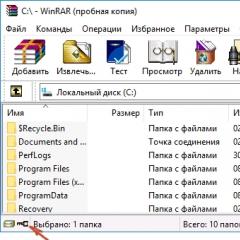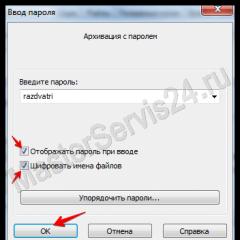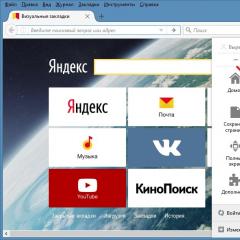How to archive a file or folder with a password. How to put a password on the archive? Create an archive with rar password
Archivers are applications that allow reduce size any file without data loss. In addition to their main purpose, they allow you to set a password for the created archive. Let's look at how to do this in the most popular archivers.
Currently, WinRar is the most widespread and popular program for creating archived files. Allows compress information in format rar And zip. In addition to the fact that it has a huge number of settings, it also allows you to set passwords. It is worth noting that name encryption will only be available in rar format.
The first and most common way is:
If the above item is not in the context menu, you can simply run archiver and select the necessary files and folders in it. Press the button Add and repeat the above steps.
Another way to password protect one or all archives that will be created by the program in the future is to click key icon(bottom left) in the application interface. We set the necessary options and, if necessary, check the box “ use for all archives». 
Setting a password in 7-zip
The archiving process in this application is not much different from the previous one. You can archive using this application in formats zip And 7 z. More precisely, the program can work with a much larger number of formats, but it only allows you to set a password for these two.
The procedure is almost identical to the one described above:

We use WinZip
Now this application is used quite rarely, but nevertheless the program also allows you to archive data, but only in one single zip format.
WinRAR allows you to create both standard zip archives and your own unique format (rar). The process for archiving and setting a password is almost identical; rar, however, has an additional option available, which will be discussed below.
Setting a password for a new archive
Open WinRAR and click the "Add" button.Select the archive format, then click the “Set Password” button:
Enter it twice (I advise you to activate the “Show password” item, because before clicking “OK” it is better to check if you have made a typo. Otherwise, you will not be able to open the archive yourself):

If desired, you can enable the “Encrypt file names” option: if such an archive is opened, then no one will even be able to read the names of folders and documents without entering a password. However, this option is only available for .rar archives.
Click OK. The password-protected archive is ready.
Now, when you try to extract its contents, the following window will appear:

If the archive has already been created and needs to be protected
In such a situation, you need to add any file to it, which you can then safely delete.The procedure is the same: open the archive, click “Add”, selecting a file to add, and at this moment a window similar to creating a new archive will appear again. Press the password button again and you can set the protection.
Conclusion
The only drawback of WinRAR is that the program is paid. Therefore, it makes sense to use it only if you need to have an archive in .rar format. When working with other options (zip and others), free analogues like 7Zip are perfect, as they also allow you to set a password and reliably protect your content.
An archive with a password will allow you to secure data in many cases, for example when sending it by email. You can place scans of your passport or other important documents in the archive. If an archive file is protected by a password and ends up in the hands of an unauthorized person, he is unlikely to be able to look into it, provided that the password is sufficiently complex and the archive does not fall into the hands of a hacker :)
How to set a password for an archive
To work, we need the Win RAR archiver, which can be downloaded for free from the developers’ website.
Let’s add the “Secret Documents” folder located on the desktop to the archive. The folder contains three graphic files. You can place any files in the archive: text, graphics, sound.

We will add the “Secret Documents” folder to the archive
Note. If you are creating an archive in order to reduce the weight of files, then do not forget that files such as JPEG, GIF, MP4 are poorly compressed.
We will perform the steps to create an archive and set a password.
Step 1. Right-click on the “Secret Documents” folder and select the command in the context menu Add to archive.

In the context menu, select the “Add to archive” command
Step 2. On the General tab you can change the name of the archive. By default, we are offered to create an archive with a name that matches the folder name. Leave the archive format as RAR and click on the button Set password.

Click on the “Set password” button
Step 3. Enter the password and click OK.

Enter the password and click “OK”
Note. A strong password must contain uppercase and lowercase letters, as well as other symbols. An example of a strong password is “r@Ud%(4gR(2”.
Remember (save) the password well - if you forget the password for the RAR archive, then in this case you will have to guess the password. The Rar Password Unlocker program is suitable for brute-forcing passwords, but if the password is complex, it is not so easy to go through all the options.
Step 4. All that remains is to click on the OK button on the “General” tab. That's it - the archive with the password has been created.
How to open an archive with a password
If you know the archive password, then unpacking the files will not be difficult.
You can set a password in WinRAR for any archive during its creation. Follow the instructions (or see how it's done at).
Step 1
Select the files you want to archive through the main WinRAR window by clicking on the “Add” button, or through the Windows Explorer context menu by right-clicking on the desired files and selecting “Add to archive...”.
Step 2
A window will open in which you can select archiving options, compression method and other settings. In order to set a password for the archive in WinRAR, click the “Set password…” button. Depending on the version of the archiver, it will be either in the same window or in the “Advanced” tab.


Step 3
Enter your password in the window that opens and click OK. Be sure to write it down somewhere, because if you forget the password, it will be almost impossible to recover it (you will only have to use the brute force method to check all combinations).

Step 4
Click “OK” again to create the archive. If the files you select are large, you will have to wait a few minutes. You can select the “No compression” compression method, then the process will take much less time.

After archiving is complete, you will have created an archive that can be opened without difficulty, but when you try to extract or view the contents of the files in it, it will require a password.
Hello, dear readers of the blog site. For some reason, there are no built-in tools in Windows that would allow you to block access to a folder for those who do not know the password to access it.
At the same time, this simplest method comes to mind for any user of this operating system. keep some of your data confidential- just put a password on the folder where the “hidden” documents (files or other directories) will be stored.
Well, really, what could be more logical than to password-protect access to a certain directory and put there everything that you would like to protect from prying eyes (spouse, children, hackers, competent authorities, etc.). There may be many goals, but the solution seems obvious - make a kind of safe out of any folder, the code for which only you will know (and how to come up with it, read the article).
How to set a password for a folder after archiving it
However, there are still no simple solutions to this problem (using tools built into Windows). More precisely, there are a number of methods that do not guarantee any confidentiality, but only provide “fool protection”. It doesn't make much sense to rely on them. In this same publication I want to focus on a way to make a safe of the highest security category from any catalog, but for this you will have to install an additional program in the OS.
It was originally built on open source and a priori () did not contain bookmarks that would allow developers to access your password-protected data. Unfortunately, the developers have now sold themselves to BitLocker, whose products are already closed source, which means your password folders can, if desired, be opened using backdoors. However, TrueCrypt can still be found and used for your purposes.
But first, I’ll give you an easier-to-use, but less reliable method (the competent authorities and specialists will be able to hack the directory, but your relatives and friends will not). It lies in the fact that the necessary the folder can be archived with a password, so that a person who does not know it would no longer be able to carry out the unzipping process.
You are all probably very familiar with archivers. Among them there are both paid and free versions. But in addition to its main functionality - creating archives to save disk space and speed up data transfer over the Internet, modern archivers allow you to encrypt archived data and protect it with passwords. It is this opportunity that we will take advantage of.
Let's try to archive a folder and put a password on it, first using the example of a free archiver (7-Zip), and then using the example of a paid one (WinRAR), which, however, is installed on almost all computers. I think that you have at least one of them, and if not, you can always install them by going to the official websites of the developers of these programs ().
How to archive and password protect a directory in 7-Zip
So, if you have an archiver installed on Windows 7-Zip, then in order to archive any folder (or a set of files and directories) in it, it will be enough to right-click on it and select “7-Zip” - “Add to archive” from the drop-down context menu:

As a result, you will see the archiving settings window, where, in addition to other settings, you can set a password to access this archive, or rather, encrypt the entire contents of the folder (while archiving it), and this code will be the key to decryption.

A feature of “archiving with a password” of directories via 7-Zip is that you can enter the created archive (folder) without entering a password, and when you try to open any file you will be required to enter it:

If you want to password-protect access not only to the files in this directory, but also prohibit viewing the contents of this folder without entering a password, then simply check the “Encrypt file names” box in the archiving settings window (second screenshot from here). After this, when you try to view the contents of the archive, a prompt to enter a password will pop up.

How to set a password when archiving a folder in WinRAR
You can also use the capabilities of the second of the archivers mentioned above to simultaneously archive and password protect a folder - WinRAR. As I already mentioned, it’s paid, but for some reason in RuNet they don’t really take it into account.
If WinRAR is already installed in Windows, then simply right-click on the directory where you want to set a password and select “Add to archive” from the context menu:

In the window that opens, go to the “Advanced” tab and click on the “Set password” button:

Here you will be asked to create and enter a password, which will become the key to your archived folder, and you can also check the “Encrypt file names” box so that no one can view the contents of the archive without entering the password (we already talked about this a little higher):

After that, click OK twice and try to enter the created archive using the password you created. If everything worked out, then you can delete the original folder, the contents of which need to be hidden from prying eyes. And as needed, you will simply log into this archived and password-protected folder. It's a little stressful to have to enter your password all the time, but security requires sacrifice. IMHO ()
How to put a strong password on a folder using TrueCrypt
As I mentioned just above, there are various programs that allow you to implement an idea that is so obvious to Windows users - to block access to a folder using a password. There are quite a few such programs (for example, Folder Lock, DirLock, Anvide Lock Folder, File lock, Lim LockFolder, etc.), but a user who understands computers will most likely be able to bypass them. Therefore, if you want to hide something from your household or work colleagues on your computer, then they will suit you just fine.
But often something more radical is required, when hacking a password-protected folder will require monstrous efforts and computing power, which will naturally deter most potential hackers. This type of tool includes the TrueCrypt program, which allows you to set a password not only for a directory, but even for the entire computer (to completely encrypt the system partition, if you need it).
I have already written in some detail about working with her:
Unfortunately, today the developers no longer release new versions of the program, because they switched to working in BitLocker (Microsoft), but you can download TrueCrypt one of the latest versions via this link. In any case, it works great for me.
Let me explain a little what “put a password on a folder” means in TrueCrypt, because this is somewhat different from the options discussed above. In this program, you create a container from any file that is on your computer and has just been created.

It will be very difficult to discover that it is a container for something, and besides, inside this container (actually a folder with files and other directories) you can create a hidden container, which certainly no one will guess about. Hackers very actively use this program to hide, for example, their correspondence, because it is difficult to even find corrupted (encrypted) information, not to mention hacking it.
So, this very container is encrypted and decrypted on the fly (you won’t even notice it) and you can work with it as with a regular directory (even more like with a portable hard drive or flash drive, because this password-protected folder is connected in Windows exactly as a new virtual disk).

That. it will be possible to copy something there, delete it, transfer it using standard operating system tools (via Explorer or, for example, Total Commander).

At the end of the work, you simply unmount the virtual disk, and no one will be able to access your data (who does not know the password). Wonderful thing.

For all the details of working with TrueCrypt for setting passwords on a flash drive, folder, or even the entire computer, see the links given just above. And remember that absolute protection does not exist (you can provide the password yourself under pressure), but among all other methods of data protection, this program is one of the most optimal options. IMHO.
Good luck to you! See you soon on the pages of the blog site
You might be interested
 TrueCrypt - how to put a password on a folder or computer, as well as password and encrypt a flash drive My username and password - what is it, how to create it correctly and store it safely
TrueCrypt - how to put a password on a folder or computer, as well as password and encrypt a flash drive My username and password - what is it, how to create it correctly and store it safely  File - what is it and how to configure file in Windows
File - what is it and how to configure file in Windows  Dropbox - how to use cloud data storage, as well as working with the Dropbox program on a computer and mobile
Dropbox - how to use cloud data storage, as well as working with the Dropbox program on a computer and mobile  KeePass is a complex password manager and generator, as well as the best program for storing and conveniently using passwords How to search the contents of files in Total Commander
KeePass is a complex password manager and generator, as well as the best program for storing and conveniently using passwords How to search the contents of files in Total Commander  How to convert a Word document (doc) to a PDF file, as well as convert it to FB2
How to convert a Word document (doc) to a PDF file, as well as convert it to FB2  SEObar - a convenient and informative SEO plugin for Opera
SEObar - a convenient and informative SEO plugin for Opera



